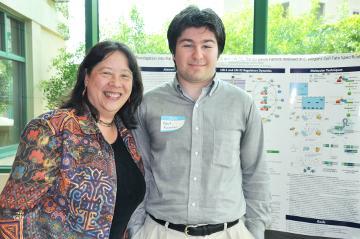
Investigation into the regulatory dynamics of LIN-1 and LIN-31, Transcription Factors Involved in C. elegans cell fate specification.
Robert Kousnetsov
Faculty Mentor: Leilani Miller
The Hox gene lin-39 may play a role in initiating the 1° cell fate during vulval development in C. elegans. This cell fate specification process is triggered by a EGFR/Ras/MAPK signal transduction cascade, wherein the transcription factors LIN-1 and LIN-31 are activated in order to upregulate expression of lin-39. Prior to activation, LIN-1 is SUMOylated and serves as a transcriptional repressor, while LIN-31 may exist as a heterodimer with LIN-1 and may also act as a transcriptional repressor. Phosphorylation converts LIN-1 and LIN-31 into transcriptional activators and may disrupt their potential heterodimer. Structural analysis of LIN-31 suggests that it may be SUMOylated and that it may interact with SUMO noncovalently. Altogether, these findings may imply that LIN-1 and LIN-31 are concurrently regulated, such that SUMOylation acts as an OFF switch and phosphorylation acts as an ON switch for transcriptional activity. Electrophoretic mobility shift assays (EMSA), yeast two hybrid (Y2H) screening, or chromatin immunoprecipitation with sequencing (ChIP-seq) will be used to determine the precise binding site of LIN-1 and LIN-31 on the lin-39 promoter and to test the heterodimerization between LIN-1 and LIN-31. Further experiments with the CRISPR/Cas9 genome editing system will query whether particular structural elements on each transcription factor are necessary for proper regulation of vulval development.